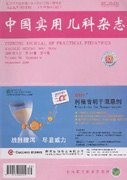|
Clinical analysis of intestinal lymphangiectasia in 18 children
WANG Hong-li,GENG Lan-lan,CHEN Pei-yu,et al
2021, 36(1):
42-46.
DOI: 10.19538/j.ek2021010610
Objective To investigate the clinical manifestations,diagnosis,treatment and prognosis of intestinal lymphangiectasia(IL) in order to improve the levels of diagnosis and treatment of IL in children. Methods The clinical data,laboratory examinations,gastroenteroscopic findings,histopathological examinations and other results of 18 children with IL were analyzed retrospectively,who were diagnosed in the Department of Gastroenterology of Guangzhou Women and Children’s Medical Center from January 2010 to December 2019. Compare the related indicators between the children with onset age within 1 year old and those over 1 year old. Results Among 18 children with IL,there were 8 boys and 10 girls;there were 13(72.2%) children with the onset age younger than 1 year old,while 5(27.8%) children with onset over 1 year old;the main clinical manifestations of IL were edema(17,94.4%),abdominal distention(16,88.8%),diarrhea(15,83.8%),ascites(16,88.8%) and being complicated with infection(14,77.7%). There was no significant difference between the two groups in gender,lymphocyte absolute count,serum albumin,globulin,IgG or positive histopathology(P>0.0 5). However,there was significant difference between the two groups in terms of infection rate(χ2=4.11,P<0.05). One case(5.6%) was lost in follow-up,and 15 cases(83.3%) had good prognosis. The diet rich in medium-chain triglyceride(MCT) was effective. Two cases needed supplementation with the serum albumin irregularly. Conclusion The main clinical manifestations of IL are edema,abdominal distention and diarrhea,which is likely to be combined with ascites and infection;the younger the onset age,the more susceptible to be infected and the higher the risk of critical illness. The diet rich in MCT is effective and should be in long-term maintenance;a small number of children need irregular supplementation with the serum albumin. Long term follow-up is needed for future prognosis.
|

